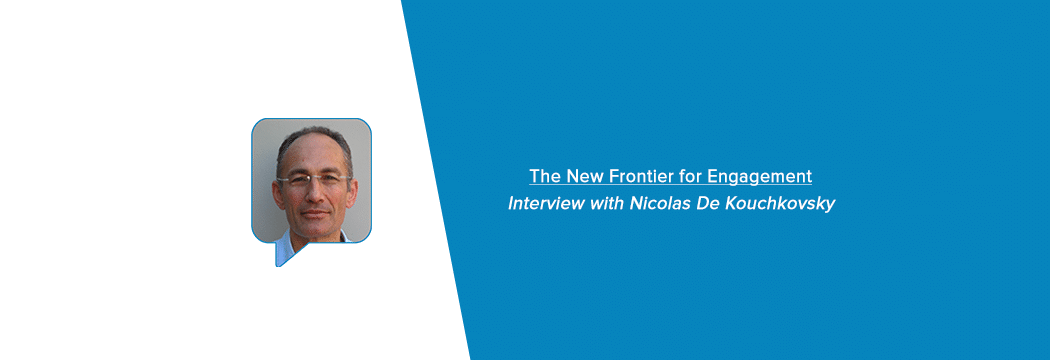Currently reveling in his role as Chief Marketing Officer at Servion and Acqueon, Nicolas de Kouchkovsky is regarded as an experienced advisor and expert in the areas of B2B software, startups, and customer experience.
During the course of this interview, Nicolas gave us insights on the importance of the relationship between the contact center and unified communications, plus the need to find balance with AI/automation implementation.
Could you tell us about your professional journey? What was your introduction to strategic business development and your experience in the contact center industry?
An engineer by trade, one of my first projects was to build a telesales system in the early days of what was then CTI, Computer Telephony Integration. It gave me early exposure to the contact center industry.
A few years later, I landed at Alcatel (now Nokia), when call centers started to take off. The company was late to the market, and we had to do something different. I ended up building an automated call distributor system (ACD) offering specifically designed for the highly distributed European market. It was very successful and drove a considerable growth that allowed us to acquire Genesys in early 2000.
Back then, there was a disruption in the making from hardware to software. So, instead of merging and disrupting the market with software solutions– into Alcatel–a hardware provider–, we did the reverse. It became an independent call center entity for Alcatel. It allowed us to embrace the software approach. I joined it and moved to the US. We went after the market, then dominated by other PBX vendors, and were able to get our unfair share of the transition. This is what turned Genesys into a dominant force in the market, allowing me to grow into marketing.
About seven years ago, I needed a change and became a fractional CMO, working with startups and mid-sized companies to help them at critical junctures of their growth journey. I became involved in a few different industries until a few years ago, when I noticed a new disruption in the making for the contact center market.
I became active again in the industry and, earlier this year, I joined a company called Servion, a customer experience solution provider, as CMO. I am also CMO for Acqueon, a SaaS spinout building conversational engagement software.
That has been my journey until now, which I guess qualifies me as a veteran of this industry.
You have observed the evolution of CCaaS in the past few years and its relation with WFO and UCaaS. Can you share with us what learnings we need to get from that evolution, and what does it tell us about the future?
Contact Center and WFO have been on a converging trajectory for quite a while. At the same time, WFO has gotten much more prominent than recording and QM. So, at the same time, we are seeing the coming together of these two categories, we also see new best of breed applications emerging such as speech analytics or performance management.
Contact Center and Unified Communication is a bit of a different story. We have seen the pendulum swinging back and forth over the years between buying the two together or as best of breed solutions. The combination of the two has a lot to do with the complexity of contact centers. Buying them together has been for many businesses a way to get contact center technology as an extension of their communications solution. It definitely makes tons of sense for the low-end of the market. Now, with the cloud, a lot of the contact center complexity is going away. It’s also much easier to integrate software purchased separately.

Do you have some advice on building a Customer Service Strategy? Is it mostly a matter of organization or technology?
On the organizational side, the historical complexity of the contact center is such that IT and technically-savvy people mostly handled it. The importance of customer experience is forcing organizations and technology to come together. You start to see the most advanced companies thinking no longer just about customer service. It is about sales; it is about marketing. They adopt a customer journey approach, with many more organizations involved.
With the expanding customer service scope and the flurry of new technologies available are making it harder for most companies. More are looking at partners to help navigate what sometimes feels like a maze. They are also looking at partners because they can’t do everything by themselves.
The importance of customer experience is forcing organizations and technology to come together. Share on X
Should companies automate their Contact Center, and, if so, how can they go about doing so?
I think that automation has become imperative for almost every business. A datapoint I always like to mention is from Gartner: the volume of interactions is going to grow three and a half times in the next five years – between 2017 to 2022. That is a massive growth in volume. And there is no other way to handle it than automation.
The way I look at automation is broad and encompasses assistance for human work. My definition of automation includes self-service, on the web, or with speech over the voice channel, biometrics, robotic automation, workflow technology, etc. There are all kinds of techniques that can be used for it.
Therefore, I think the question shifts to ‘should I automate’ to ‘what should I automate and how to do it?” This is where the dialogue is heading. It is one of the current practices of my company, and I am passionate about it.
What challenges face AI-Enabled Employee Experiences?
One aspect of AI is how you can improve the life of the employees, but I would like to look at it more broadly as employees also play a critical role in enabling AI.
I have done multiple projects in this space using different technologies, offering various solutions aiming at improving efficiency and perfecting the customer experience. I consistently heard from practitioners that they found it way harder to implement. The amount of effort and time that they have to put in is much higher than they thought, and results can be disappointing. One of the common themes is knowledge. AI is as good as you can train the system, and educating the system without the people is very, very hard.
So, there are two things that organizations need to do: they need to embark people on the AI transformation and find ways to harness human talent to train the AI and bring in their knowledge.
For this to succeed, you need to find ways for AI to help people. One of the use cases that is becoming increasingly popular in the contact center space is “how can I use AI to assist with suggestions and better categorization of inquiries.”
The two considerations need to come together, and the role of people in those projects needs to be considered with great care.

How important are messaging apps in the Contact Center?
I think messaging is super essential for the contact center customer experience. We have seen over the years, new ways, new interaction channels popping up. Every time a new one pops-up, people get excited. They think it is going to replace everything. But over time, it just becomes yet another channel.
For me, I think there is something different and unique about messaging. It is conversational, and it provides a persistent context. So, when you dialogue using messaging, it is a real dialogue. The beauty of it is that you can pause it without losing meaning. It is embedded in the conversation, and you can quickly reconnect to it.
For me, I think there is something different and unique about messaging. It is conversational, and it provides a persistent context. Share on X
As a by-product, it [messaging] gives back time to customers. Being on-hold has always been one of the most frustrating experiences for customers. It also gives back time to organizations, because, if you don’t know the answer, instead of telling the customer “stay with me a second,” you can look for it while the customer is doing something else. In the end, when you look at the experiences that can be offered using messaging, it’s not much longer than a call. If you compare it to email, the email experience is often disconnected and hard to reconnect. So, it’s very different.
Eventually, a beautiful thing about messaging is that, because of the shared context, you can add automation easily to the experience.
As a by-product, messaging gives back time to customers. Being on-hold has always been one of the most frustrating experiences for customers. Share on X
How important is it to be Omni-Digital? To be available across multiple digital channels for your customers and be where they are?
You do want to be available on every channel. Also, with messaging channels, you find that different people prefer different messaging apps and want to support all of them.
Now, my observation is that vendors are mostly pushing omnichannel customer service as being where your customers are. It can be dangerous to start treating all the channels equally, enabling customers to do whatever they want over anyone. It won’t improve the customer experience.
Some channels are better suited than others for certain things. So, I am a big proponent of brands telling customers the best channel to accomplish what they are trying to do.
Is there anything else you would like to talk about?
Automation is imperative but needs to be balanced. If you believe that business success ties to customer intimacy, you have to be careful about automating everything because it can remove you from your customers. So, you want to balance automation with engagement.
This is hard. With the proliferation of channels, customers expect to be contacted on their terms. This is the new frontier for engagement. It’s how you do it that matters. It needs to be in context, using the right channel and equipping your people with the information they need to have a meaningful conversation with customers.
To discover more about Nicolas and the companies he works with, you can follow him on Twitter, LinkedIn, and his website.
Originally published Dec 05, 2019, updated Aug 06, 2024





